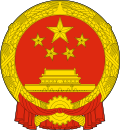Village (China)
The village , more precisely "administrative village " ( Chinese 行政 村 , Pinyin xíngzhèngcūn ) is the lowest administrative unit in the rural areas of the People's Republic of China. In urban areas it corresponds to the community of residents , in the pasture areas of Inner Mongolia the Gaqaa . Either the municipality or the large municipality stands above the village . An administrative village can consist of several "natural villages" ( 自然村 , zìráncūn ) and then corresponds to the Bavarian administrative community .
The political representation of the administrative village is the village committee ( 村民委員會 / 村民委员会 ), the village director ( 村主任 ) projects, "Village of colloquially usually head " or "village mayor " ( 村長 / 村长 ) is called. In contrast to the urban community of residents, the administrative village is largely organized according to the principle of the cooperative , similar to the German machine rings . As at all administrative levels in the People's Republic of China, there is also a parallel structure of the Communist Party of China in the village . According to the village committee there is a party committee ( 中 [國] 共 [產 黨] 委員會 / 中 [国] 共 [产 党] 委员会 ), according to the village head there is a party secretary ( 黨委 [員 會] 書記 / 党委 [员 会] 书记 ). The party committee is always housed in the same building as the village committee, possibly together with other local authorities.
Here, for example, the administrative center of the village Baiwan ( 白灣村 / 白湾村 ) in the municipality of Xiqiuwan the circle Badong in the southwestern province of Hubei .
On the far right and in red letters the sign of the Committee of the Baiwan Cell of the Communist Party of China ( 中共 巴東 縣 溪 丘灣鄉 白灣村 支部 委員會 / 中共 巴东 县 溪 丘湾乡 白湾村 支部 委员会 ), next to it on the left Village Committee ( 白灣村 村民 委員會 / 白湾村 村民 委员会 ), then the staff of the village militia company ( 白灣村 民兵 連 / 白湾村 民兵 连 ), then the Public Safety and Opinion Polling Committee ( 白灣村 治 [安] 保 [衛] 民 [意] 調 [查] 委員會 / 白湾村 治 [安] 保 [卫] 民 [意] 调 [查] 委员会 ; corresponds roughly to the German regulatory authority ), then the local office of the biogas plant -Maintenance network ( 白灣村 沼氣池 後續 服務 網點 / 白湾村 沼气池 后续 服务 网点 ). At the top of the facade, as in all official buildings in China, is written "In the service of the people" ( 為人民服務 / 为人民服务 , wèi rénmín fúwù ) in Mao Zedong's calligraphy :
While there were around 1 million administrative villages in China at the beginning of the 1990s, a community reform took place from around 2000 under the name "Association of Administrative Villages " ( 合併 行政 村 / 合并 行政 村 ), which reduced their number to 625,147 by 2004. Before the community reform, around 1,000 people lived in an administrative village in central China and the coastal areas of the southeast, compared to only a few hundred in the sparsely populated west. Today more than 2000 people live in the coastal regions in an administrative village, which then consists of several “natural villages”.
As a relic from the time of the people's communes (1957–1978), the villages are still divided into so-called “working groups” ( 村民 小組 / 村民小组 ) of around 50 households. Today, however, this detailed structure only serves to specify postal addresses and, although there are group leaders elected by the working group, no longer has an administrative function. The administrative village as a whole decides in a village assembly in which all villagers from the age of 18 are entitled to take part in all questions relating to investments in community projects, the use of the income from said projects, the expense allowance for the (always voluntary) members of the village committee, etc. are.
Web links
- "Law of the People's Republic of China on the Organization of Village Committees" from November 4, 1998 to the 9th NPC (English)
- Organic Law of the Villagers Committees of the People's Republic of China from November 4, 1998 - on npc.gov.cn (English)
Individual evidence
- ↑ stats.gov.cn
- ↑ The sign of the party structure always hangs on the far right, on all administrative levels and also on party committees in companies. Red characters are always used.
- ↑ gov.cn
- ↑ newenergy.in-en.com
- ↑ Regarding the community reform that was part of the solution to the “Three Problems in Rural Areas”, see also archive.is
- ↑ The working group was the organizational level below the production group ( 生產 隊 / 生产 队 ), above which the production brigade ( 大隊 / 大队 ), which corresponds to today's administrative village , stood.
- ↑ china.org.cn Articles 17-19.


